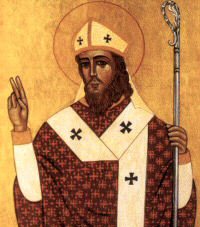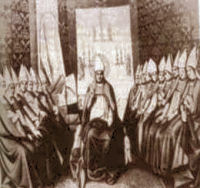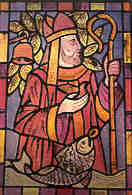
Calling of Peter and Andrew
Duccio di Buoninsegna
1308-11
Tempera on wood, 43,5 x 46 cm
National Gallery of Art, Washington


Daily Readings for:January 13, 2014
(Readings on USCCB website)
Collect: Grant, we pray, almighty God, that we may rightly understand and truthfully profess the divinity of your Son, which the Bishop Saint Hilary taught with such constancy. Through our Lord Jesus Christ, your Son, who lives and reigns with you in the unity of the Holy Spirit, one God, for ever and ever.
RECIPES
ACTIVITIES
o Namedays
PRAYERS
o Book of Blessings: Blessing Before and After Meals: Christmas Season (2nd Plan)
o Book of Blessings: Blessing Before and After Meals: Christmas (1st Plan)
o Prayer for Perseverance in Faith
LIBRARY
o Saint Hilary of Poitiers | Pope Benedict XVI
o The Saintly Scholars of the Church | Fr. Stephen McKenna
· Ordinary Time: January 13th
· Optional Memorial of St. Hilary of Poitiers, bishop and doctor; Memorial of St. Kentigern, bishop (Scotland)
Old Calendar: Commemoration of the Baptism of Our Lord Jesus Christ
St. Hilary of Poitiers was one of the great champions of the Catholic belief in the divinity of Christ. By his preaching, his treatise on the Trinity, his part in the Councils, his daring opposition to the Emperor Constantius, he showed himself a courageous apostle of the truth. He could not tolerate that the specious plea of safeguarding peace and unity should be allowed to dim the light of Gospel teaching. St. Pius IX proclaimed him a doctor of the Church.
In Scotland St. Kentigern's feast is a memorial. He was a missionary to Scotland and bishop of the Strathclyde Britons. Exiled, he fled to Wales.
According to the 1962 Missal of Bl. John XXIII the Extraordinary Form of the Roman Rite, today is the feast of Commemoration of the Baptism of Our Lord Jesus Christ.
St. Hilary
St. Hilary was one of those great Christian heroes who poured out their lives laboring and suffering in defense of Christ's divinity. Scarcely had the days of bloody persecution ended (313), when there arose, now within the Church, a most dangerous enemy of another sort, Arianism. The heresy of Arianism denied the divinity of Christ; it was, in fact, hardly more than a form of paganism masquerading as the Christian Gospel. The smoldering strife soon flared into a mighty conflict endangering the whole Church; and its spread was all the more rapid and powerful because emperors, who called themselves Christian, proved its best supporters. Once again countless martyrs sealed in blood their belief in Christ's divinity; and orthodox bishops who voiced opposition were forced into exile amid extreme privations.

Among the foremost defenders of the true faith stood Hilary. He belonged to a distinguished family and had received an excellent education. Though a married man, he was made bishop of Poitiers by reason of his exemplary life. It was not long before his valiant defense of the faith precipitated his exile to Phrygia. Here he composed his great work on the Blessed Trinity (in twelve books). It is a vigorous defense of the faith, which, he said, "triumphs when attacked." Finally, after four years he was permitted to return to his native land. He continued his efforts, and through prudence and mildness succeeded in ridding Gaul of Arianism. Because of his edifying and illustrious writings on behalf of the true religion, the Church honors him as one of her doctors.
Here is an example of Hilary's vigorous style: "Now it is time to speak, the time for silence is past. We must expect Christ's return, for the reign of Antichrist has begun. The shepherds must give the warning signals because the hirelings have fled. Let us lay down our lives for the sheep, for brigands have entered the fold and the roaring lion is rampaging about. Be ready for martyrdom! Satan himself is clothed as an angel of light." A favorite motto of St. Hilary was, Ministros veritatis decet vera proferre, "Servants of the truth ought speak the truth."
— From Pius Parsch, The Church's Year of Grace, Pius Parsch
Patron: Against snakes; backward children; snake bites.
St. Kentigern
St. Kentigern was also known as Mungo ("dear one" or "darling"), his mother was a British princess named Thenaw (or Thaney or Theneva). When it was discovered that she was pregnant of an unknown man, she was hurled from a cliff and, when discovered alive at the foot of the cliff, was set adrift in a boat on the Firth of Forth. She reached Culross, was given shelter by St. Serf, and gave birth to a child to whom Serf gave the name Mungo. Raised by the saint, he became a hermit at Glasgow and was so renowned for his holiness that he was consecrated bishop of Strathclyde about 540. Driven to flight because of the feuds among the neighboring chieftains, he went to Wales, met St. David at Menevia, and founded a monastery at Llanelwy. About 553, Kentigern returned to Scotland, settled at Hoddam, and then returned to Glasgow, where he spent his last days. He is considered the first bishop of Scotland and with Thenaw is joint patron of Glasgow.
— From John J. Delaney, Dictionary of Saints
Glasgow's Coat of Arms includes a bird, a fish, a bell and a tree; the symbols of Kentigern.
The Bird commemorates the pet robin owned by Saint Serf, which was accidentally killed by monks who blamed it on Saint Kentigern. Saint Kentigern took the bird in his hands and prayed over it, restoring it to life.
The Fish was one caught by Saint Kentigern in the Clyde River. When it was slit open, a ring belonging to the Queen of Cadzow was miraculously found inside it. The Queen was suspected of intrigue by her husband, and that she had left with his ring. She had asked Saint Kentigern for help, and he found and restored the ring in this way to clear her name.
The Bell may have been given to Saint Kentigern by the Pope. The original bell, which was tolled at funerals, no longer exists and was replaced by the magistrates of Glasgow in 1641. The bell of 1641 is preserved in the People's Palace.
The Tree is symbol of an incident in Saint Kentigern's childhood. Left in charge of the holy fire in Saint Serf's monastery, he fell asleep and the fire went out. However he broke off some frozen branches from a hazel tree and miraculously re-kindled the fire.
Patron: Glasgow, Scotland; salmon.
Symbols: Bell; bird; fish; ring; robin; salmon; tree.
Things to Do: